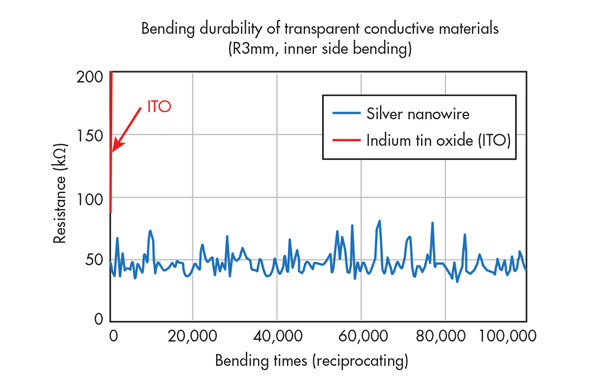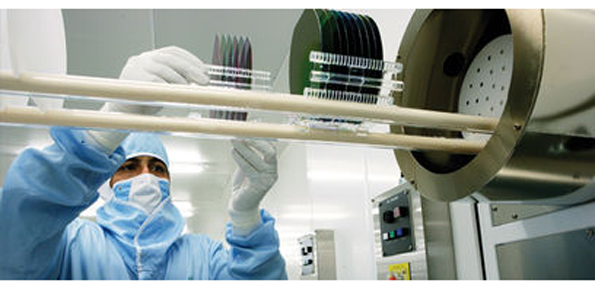



Feature Story
More feature stories by year:
2024
2023
2022
2021
2020
2019
2018
2017
2016
2015
2014
2013
2012
2011
2010
2009
2008
2007
2006
2005
2004
2003
2002
2001
2000
1999
1998
 Return to: 2015 Feature Stories
Return to: 2015 Feature Stories
CLIENT: CAMBRIOS
Sept. 29, 2015: Electronic Design
By John LeMoncheck, Cambrios Technologies
 Displays are everywhere. They come in a range of shapes and sizes, employing an even wider range of technologies designed to deliver better performance and higher-quality images while using less power. One emerging technology uses silver nanowires.
Displays are everywhere. They come in a range of shapes and sizes, employing an even wider range of technologies designed to deliver better performance and higher-quality images while using less power. One emerging technology uses silver nanowires.
Cambrios Technologies is heavily involved in delivering technology using silver nanowires. I recently talked with John LeMoncheck, CEO at Cambrios, about these technology trends and how Cambrios is addressing them.
Wong: What are some of the technology and market challenges in your industry?
LeMoncheck: As with other tech categories, the pace of change and challenges of out-innovating ourselves and other players are most significant. We never rest on our laurels. Listening, interpreting, and responding to customer requirements, as well as creating value that customers may not have even thought of, are all key pieces. New technologies that are synergistic to ours are constantly providing us opportunities to explore new applications; our product has a lot of potential and we are enabling many cutting-edge devices. In our core markets, prices have fallen at a rate of over 15% in the past three years, so it takes a versatile technology like ours to weather this onslaught and we have done quite well. The market continues to demand better and better product performance and this bodes well for our technology.
Wong: What are some of the significant changes occurring now in display and touch technology?
LeMoncheck: We're closely focused on the fast growing range of applications for flexible touchscreens that traditional materials cannot address. This change from rigid to flexible touchscreens is most significant. We're helping lead that change by informing the markets of the tremendous design potential that can be offered in new products that better serve people and allows more sustainable and environmentally responsible manufacturing.
Wong: How does silver-nanowire technology currently compare to ITO (indium tin oxide) film-based solutions?

1. Testing shows silver-nanowire (AgNW) displays bent at 3-mm radius perform better than ITO (data courtesy of the Nissha Printing Company, Japan).
LeMoncheck: That's a question we're always answering. There's a powerfully compelling difference. Silver-nanowire technology offers higher transmission, lower resistance, and is 40% thinner and lighter than ITO sensors (see "What's The Difference Between Silver Nanowire And ITO For Touchscreens?"). And its flexibility is resulting in a growing array of product possibilities. Single-layer sensors that are twice the size of what's possible with ITO or metal mesh can be made and at lower manufacturing cost; there's no chemical waste and less energy consumption, resulting in greener products. The technology even makes it possible to create flexible displays (Fig. 1).
Wong: How are silver nanowires currently being used in consumer products; provide some examples.
LeMoncheck: The places we're seeing the most uptake are in smartphones, tablets, and most significantly, in wearable devices, where flexible touch interfaces are a must-have (Fig. 2). There are also All-In-One PCs, desktop monitors, and laptops with touchscreens that help reduce weight and thickness, while providing 10-finger touch performance with no visual artifacts as is often seen with competing technologies. Our silver nanowires form the anode in an OLED lighting application, and we have enabled film-based flexible solar panels, to name some of the emerging applications.

2. Silver-nanowire technology is helping accelerate the transition to flexible/wearable devices and products.
Wong: What's the most exciting application on the horizon?
LeMoncheck: I'm most excited about wearables. There are some interesting products from our customers coming down the pike. But I think designers haven't even scratched the surface of what we'll be seeing and wearing in another few years. Medical and infotainment devices being designed today require best-in-class transparency, conductivity, and flexibility, and we are well-poised for those applications.
Wong: What types of companies are using silver nanowires as their transparent conductor of choice?
LeMoncheck: Cambrios' ClearOhm silver nanowires are being adopted as the transparent conductor of choice by Hitachi, LG, TPK, Nissha, 3M, and Okura. Several OEMs like Lenovo, Karbonn, NEC, Toshiba, and LG have shipped products ranging from mobile phones to large-area monitors using our silver nanowires. There are many others that are not yet public. The switch is on by companies in both the consumer and industrial sectors, driven by the reasons I've mentioned. As more design engineers become aware of the importance of silver-nanowire properties, the application base will broaden even more.
Wong: What do you see as the future for silver-nanowire technology, e.g., 12-24 months from now?
LeMoncheck: Forecasting in the tech sector is tricky. But smartphones and higher-end tablets will definitely see increased adoption because of the enhanced user experience and improve ruggedness and reduced power consumption. Wearables will also show serious growth as designers catch on to the great product-differentiation possibilities of flexible touch interfaces in automotive and wearable applications.
Wong: What sets Cambrios apart from your competitors?
LeMoncheck: Without sounding too boastful, I feel we're bringing more to the game. As the largest silver-nanowire supplier in the world, we have great resources and a brilliant team. Our product is simply better—while the competition is talking about lab samples, we are shipping in mass production. Our eco-system of partners, customers, and end device makers are the biggest and best in the world. Our customers are comforted by the fact that we have a large intellectual-property portfolio, developed over the years, that protects our customers and ourselves. We're investing in greater brand awareness. We have a story to tell that is resonating with people all over the world. All of those things add up to our competitive difference.
Wong: What's the best thing about being the CEO at Cambrios?
LeMoncheck: It's difficult putting a finger on one thing. The excitement, the pace, leading a team of dedicated experts in a wide variety of disciplines, and, of course, winning new business in a rapidly evolving tech category that's helping change how people live are all components of what's great about it. The sense of urgency that exists with the company. The team's determination. All of that together! Thank you for the opportunity to discuss Cambrios and our silver-nanowire technology.
Return to: 2015 Feature Stories